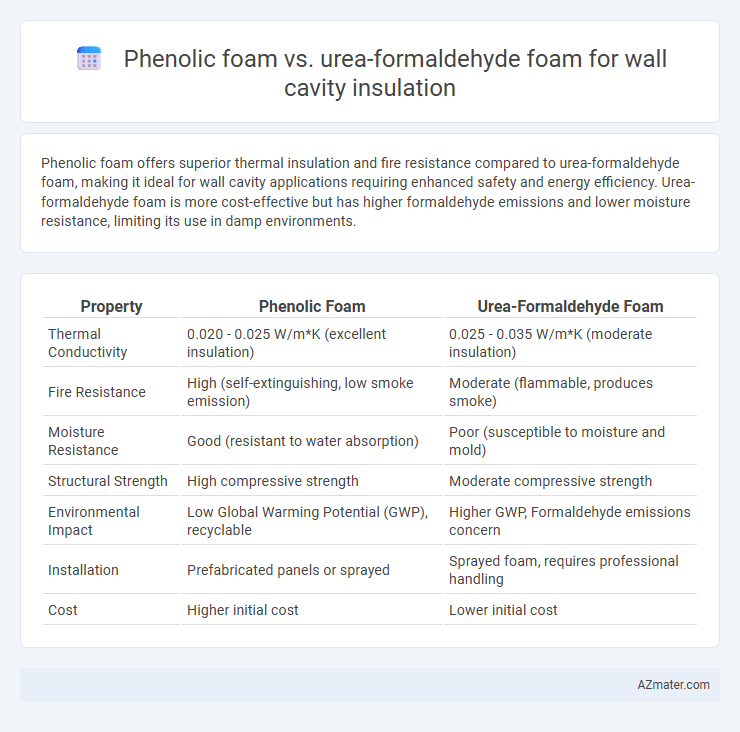Phenolic foam offers superior thermal insulation and fire resistance compared to urea-formaldehyde foam, making it ideal for wall cavity applications requiring enhanced safety and energy efficiency. Urea-formaldehyde foam is more cost-effective but has higher formaldehyde emissions and lower moisture resistance, limiting its use in damp environments.
Table of Comparison
| Property | Phenolic Foam | Urea-Formaldehyde Foam |
|---|---|---|
| Thermal Conductivity | 0.020 - 0.025 W/m*K (excellent insulation) | 0.025 - 0.035 W/m*K (moderate insulation) |
| Fire Resistance | High (self-extinguishing, low smoke emission) | Moderate (flammable, produces smoke) |
| Moisture Resistance | Good (resistant to water absorption) | Poor (susceptible to moisture and mold) |
| Structural Strength | High compressive strength | Moderate compressive strength |
| Environmental Impact | Low Global Warming Potential (GWP), recyclable | Higher GWP, Formaldehyde emissions concern |
| Installation | Prefabricated panels or sprayed | Sprayed foam, requires professional handling |
| Cost | Higher initial cost | Lower initial cost |
Introduction to Wall Cavity Insulation
Wall cavity insulation enhances thermal performance and energy efficiency by filling gaps between structural walls with specialized materials. Phenolic foam offers superior fire resistance, low thermal conductivity (approximately 0.020 W/mK), and excellent moisture resistance compared to Urea-formaldehyde foam, which has higher thermal conductivity and potential off-gassing issues. Selection between these foams impacts indoor air quality, energy savings, and overall building envelope durability.
Overview of Phenolic Foam Insulation
Phenolic foam insulation offers superior thermal performance with a low thermal conductivity typically around 0.020 W/m*K, making it highly effective for wall cavity applications. Its closed-cell structure provides excellent fire resistance, classified as Euroclass B-s1,d0, significantly reducing smoke and flame spread compared to Urea-formaldehyde foam. Phenolic foam also demonstrates enhanced moisture resistance and dimensional stability, contributing to long-term insulation effectiveness in residential and commercial buildings.
Overview of Urea-Formaldehyde Foam Insulation
Urea-formaldehyde foam insulation (UFFI) is a synthetic polymer foam used primarily in wall cavity insulation, characterized by its effective thermal resistance (R-value around 3.7 per inch). It is created through the chemical reaction of urea and formaldehyde, resulting in a lightweight, rigid foam that expands to fill cavities and reduce air leakage. Although cost-effective and good for retrofitting, UFFI's potential off-gassing of formaldehyde has raised health concerns, prompting careful ventilation and regulatory scrutiny in some regions.
Thermal Performance Comparison
Phenolic foam offers superior thermal insulation with an R-value of approximately 4.5 to 5.0 per inch, outperforming urea-formaldehyde foam, which typically provides an R-value around 3.6 to 4.0 per inch. The closed-cell structure of phenolic foam minimizes thermal bridging and air infiltration, enhancing overall energy efficiency in wall cavities. Urea-formaldehyde foam tends to have higher thermal conductivity and may degrade over time, reducing its long-term insulation effectiveness compared to phenolic foam.
Fire Resistance and Safety Analysis
Phenolic foam exhibits superior fire resistance compared to urea-formaldehyde foam, with lower flame spread and smoke development ratings, making it a safer choice for wall cavity insulation. Phenolic foam's inherent chemical structure provides enhanced thermal stability and char formation, effectively slowing fire propagation. Urea-formaldehyde foam, while cost-effective, tends to release higher levels of toxic gases such as formaldehyde during combustion, posing increased health risks in fire scenarios.
Moisture Resistance and Durability
Phenolic foam offers superior moisture resistance compared to urea-formaldehyde foam, making it less susceptible to water absorption and mold growth in wall cavity insulation applications. The closed-cell structure of phenolic foam enhances its durability by providing long-term dimensional stability and resistance to degradation from humidity exposure. Urea-formaldehyde foam, while cost-effective, tends to absorb moisture more readily, leading to potential loss of insulating properties and compromised structural integrity over time.
Health and Environmental Impact
Phenolic foam offers superior fire resistance and low smoke emission, reducing the release of harmful volatile organic compounds (VOCs) compared to urea-formaldehyde foam, which may emit formaldehyde, a known carcinogen, during installation or degradation. Urea-formaldehyde foam poses greater health risks due to formaldehyde off-gassing and potential respiratory irritation, whereas phenolic foam's chemical stability limits indoor air quality concerns. Environmentally, phenolic foam is often preferred for its lower global warming potential and better durability, while urea-formaldehyde foam's production and disposal raise concerns over toxic emissions and pollutant persistence.
Installation Process and Practical Considerations
Phenolic foam offers a straightforward installation process with excellent dimensional stability and low thermal conductivity, making it highly efficient for wall cavity insulation; it requires professional handling due to its rigid structure and sensitivity to moisture during installation. Urea-formaldehyde foam typically involves spraying or injecting, allowing it to expand and fill cavities effectively, but it demands careful application to avoid off-gassing and moisture issues that can compromise insulation performance. Practical considerations include phenolic foam's higher upfront cost balanced by superior fire resistance, while urea-formaldehyde provides cost-effective insulation but may require additional measures for long-term durability and indoor air quality.
Cost Analysis: Phenolic Foam vs Urea-Formaldehyde Foam
Phenolic foam generally incurs higher initial costs compared to urea-formaldehyde foam due to its advanced fire resistance and superior thermal insulation properties. Despite the higher upfront price, phenolic foam offers better long-term energy savings and durability, reducing lifecycle expenses. Urea-formaldehyde foam is a more cost-effective option initially, but may lead to increased maintenance and replacement costs over time due to lower moisture resistance and potential degradation.
Conclusion: Choosing the Right Insulation for Your Walls
Phenolic foam offers superior thermal insulation with a low thermal conductivity of around 0.021 W/m*K, high fire resistance, and excellent moisture resistance, making it ideal for durable wall cavity applications. Urea-formaldehyde foam provides cost-effective insulation but has higher thermal conductivity (approximately 0.028 W/m*K) and potential concerns related to formaldehyde emissions. Choosing the right insulation depends on balancing performance requirements, budget constraints, and environmental factors to ensure optimal energy efficiency and indoor air quality.

Infographic: Phenolic foam vs Urea-formaldehyde foam for Wall cavity insulation
 azmater.com
azmater.com